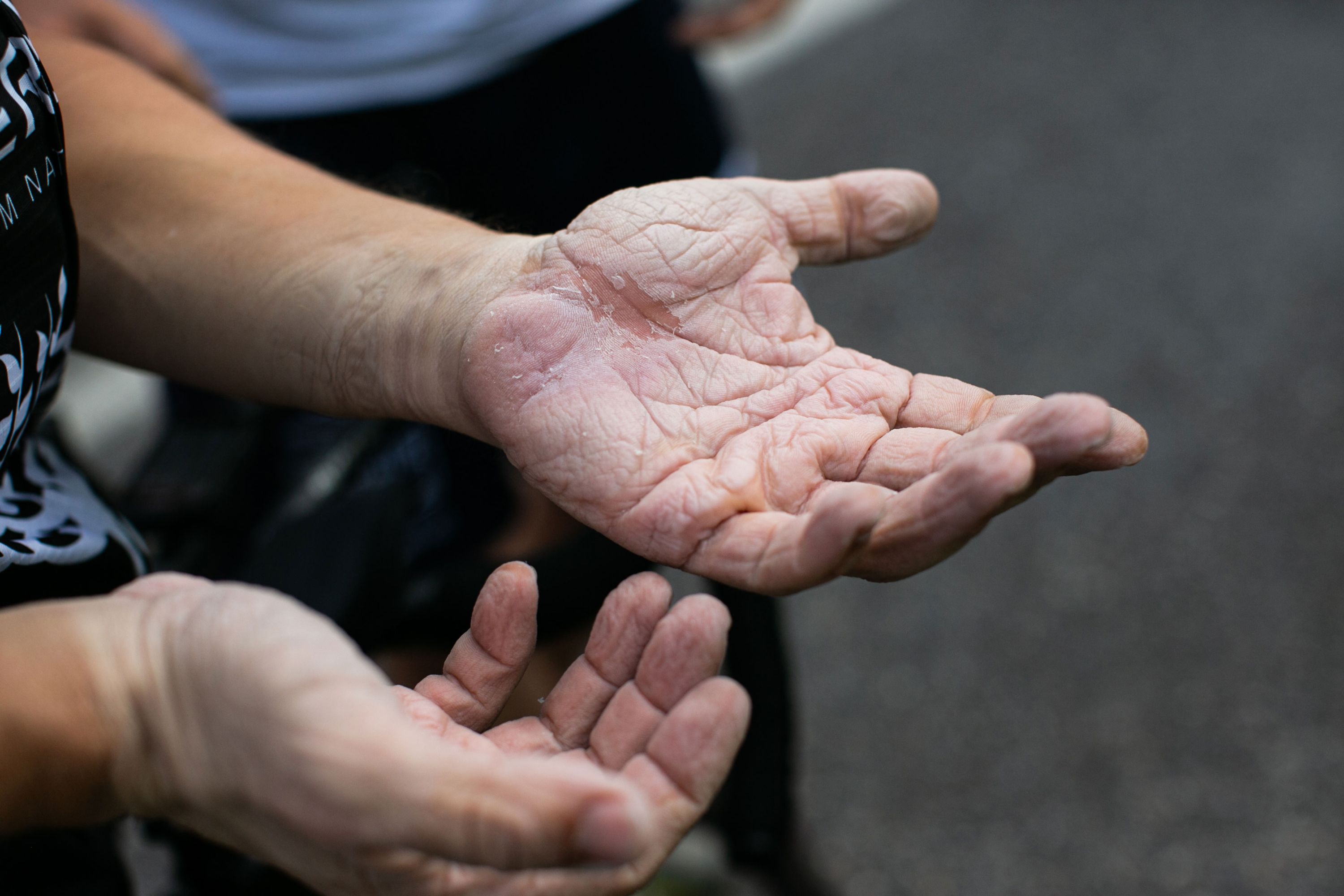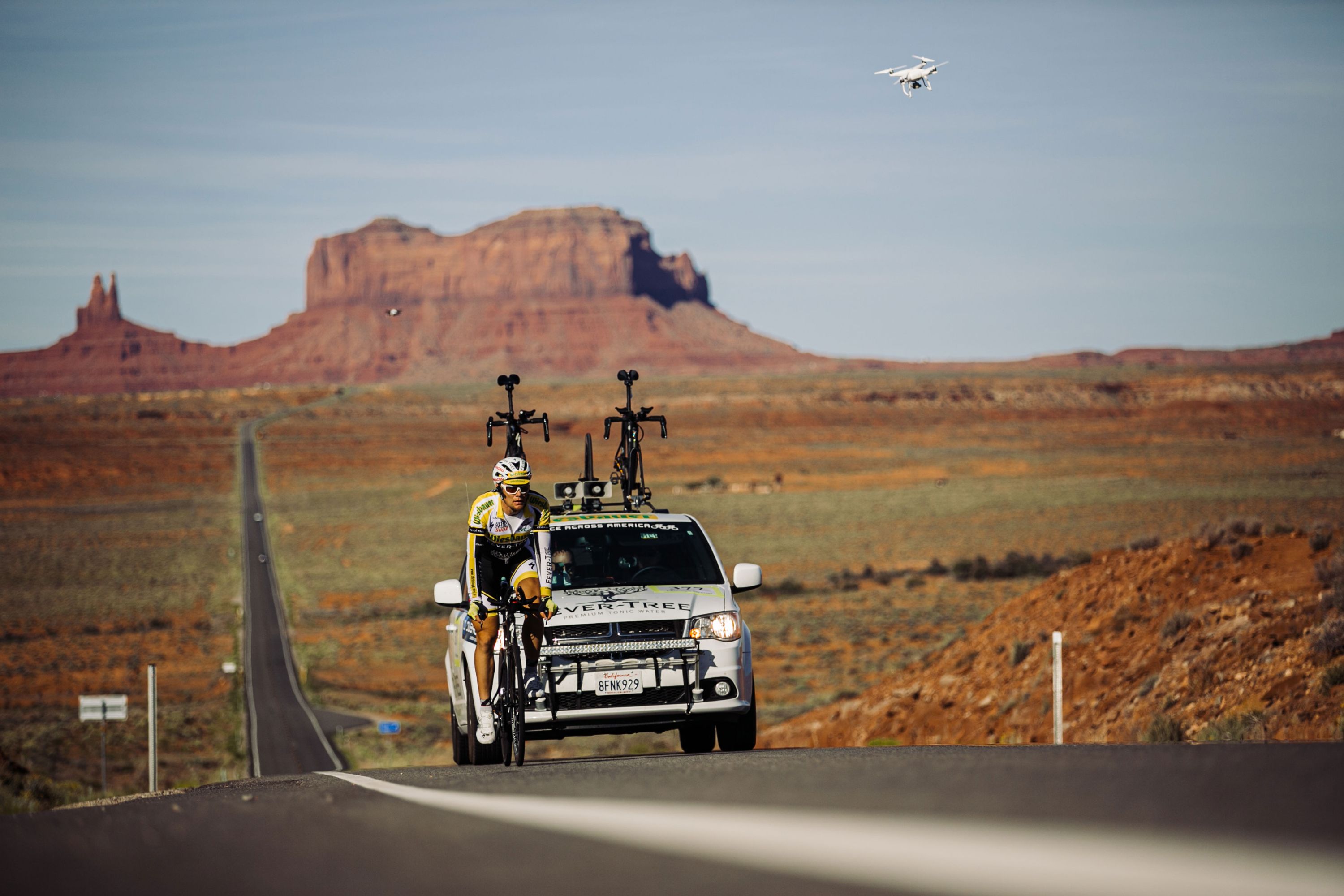
Interview with Christoph Strasser
Images: (c) Lex Karelly
In June, the Austrian Christoph Strasser won the traditional ultra-distance cycling race from the west to the east coast of America for the third year in a row and the sixth time overall. That’s a record!
4,939 km, 53,400 metres of altitude, 8 days, 6 hours, and 51 minutes. The figures are hardly fathomable – just impressive. How did you experience the race? Can you tell us about your race and the emotions you felt?
In the time leading up to the start of the race, confidence and enormous respect converge, and rightfully so. Because even though it was my 9th time participating, making it to the finish line is never a sure thing, as just so much can happen along that distance (health issues, falls, breakdowns, weather conditions). And such mishaps can equally affect titleholders and record-holders. I therefore always steer clear of feeling overly secure.
Already after five hours, after crossing the first mountains and reaching the desert, I had my first meltdown. The heat drove up my pulse, my performance plummeted, it was a real struggle on my bike, and I thought to myself: ‘How am I supposed to endure this for 8 days straight when I’m just starting out and already grinding to a halt?’ At a more laid-back pace, I was able to take refuge in the first nightfall, when it cooled down a bit, but I also faced overpowering fatigue and the threat of microsleep. I knew, however, that the first night is always one of the most difficult, because the body is still in its normal biorhythm, before undergoing a complete transition during the race. Then many problems get better or disappear entirely; even the fatigue in your head improves.
Starting from the second day, things then went relatively well. I was going at my own rhythm, managed to crank out more watts than at the beginning and upped my lead ahead of my competitors, which helped to boost my motivation.
The final two days and nights were really tough again. There was increased traffic, the deprivation of sleep wears you down and the short but very steep inclines of the Appalachians take a toll on what little stamina you have left.
This year’s difficult weather conditions were a real challenge for you. How did you cope mentally? What generally runs through your head during a race?
The bad weather – the heavy rain in the second half of the RAAM, of course, had a very negative impact at first. We knew the forecast and were aware that it would probably not really get better for days before we arrived at the finish line.
In the first days of the race, it was hot, even very hot, but that was basically the typical Arizona weather, which I was prepared for and anticipating. Now I had to struggle with the heat, and a new stellar record of less than 8 days, as I had been striving for, seemed hardly feasible. I was between 2 and 3 hours behind schedule as planned. My performance data were the same as in the preceding year (In 2018, I finished in 8 days and 1 hour), but my riding time was not very fast due to the unfavourable winds. I put myself under a lot of pressure and started brooding about why I was a few hours slower, even though I was giving it my all. When the rain also started coming down, I was initially frustrated, but soon my mood turned positive: I relinquished my mental goal of an 8-day finish, accepted the fact that it was impossible under these conditions, and strove to make the best out of the situation and reach the goal as quickly and best as possible. My good mood returned, my crew had a lot more fun, and I simply let the rain pour over me without getting worked up about it.

Physically, it was, of course, very tough, with the skin on my feet and hands suffering tremendously despite the rain protection. Completely softened-up spots and deep wrinkles developed that were painful every time I pressed down on the pedal, as though I were stepping on little, sharp stones. But the final miles of the RAAM are always gruelling. When it’s dry and warm, the hot, humid air can also prove problematic. At least this way, I was not hot and was always ‘freshly’ showered!
What generally went through my head is easy to explain: as little as possible! Since I’m connected to my crew via my headset and the accompanying car plays music, reads out messages from fans, or plays recorded ones from friends, I never really get bored. The less time I have to brood, the better. I emphasise time and again as well how important it is to have a well-coordinated team keeping me in a good mood. If I were on the go without a good team, I would hardly be able to bear the monotony of the race.
Between Oceanside on the Pacific coast and Annapolis on the Atlantic coast, you took just five sleeping breaks and seven power naps (total sleeping time: 9.5 hours). How do you prepare for such performance? What does your training look like? Can you give us an idea of your training programme?
We want to believe that handling sleep deprivation can be trained or is a special ability that not everyone has. Such situations are often compared with people’s experience of everyday life and the poor condition that you experience when you haven’t slept enough for two nights in a row.
In day-to-day situations, I am no different – I like to sleep 8 hours. I am certain, however, that everyone needs less sleep in extreme situations than in everyday life, and only in such cases does the body mobilise the necessary resources.
My anticipation of the sleep deprivation I would experience during the RAAM began already weeks in advance, so the situation was no surprise, but fully planned for. I can’t handle the fatigue alone either, but I have my team. With them, I never feel like I’m on my own and my crew gets me into conversations, cheer me up or hand me caffeinated drinks if they notice by my body language that I’m having a weak phase.

Physical training is managed by a professional coach, but it is not as extraordinary as some believe. Overly long rides or training sessions at night are not included in my plan – that would only worsen regeneration. The art is to mix long basic workout units and high-intensity intervals in such a way that I improve in both areas without getting too slow or my long-term endurance dropping.
In the six months before RAAM, this means in practice: a total of 780 training hours, including many 6–7-hour endurance units in the lower range as well as shorter ‘brutal units’ with a few 4-, 8- or 16-minute ‘all-out intervals’. The aim is to raise my FTP threshold over 5 watts/kg, which is really not easy to do over long periods of time. However, the training continues even after the RAAM. In summer, I also took part in the Race Around Austria and in September I have some time trials in store before, after a brief off-season, preparation begins for the next year.
Cycling is becoming increasingly technical. The levels of intensity are determined based on tests and laboratory values. How do you divide up your race over the nearly 5,000 kilometres? How do you control the intensity while on the go? What do you eat and drink at what intervals during the 8 days?
In my opinion, the technical aids are a big help, and I couldn’t imagine training or racing without my power2max power meter any more. There is also the electronic gearshift or the Terrano wireless communication device with headset on my helmet which I wouldn’t want to do without. Thanks to the watt-controlled training, I precisely know my watt ranges and can thus divide up and pace the race very well. In this regard as well, the RAAM is particular. Along its tremendous length, you can hardly overdo it from the second day on, because otherwise your performance drops – you can only go into overdrive within the first 24 hours. And here I can hardly go by training values, because the heat drives up your pulse, and I can’t ride the ranges I’m used to from day-to-day training for very long. At 40°C and over, there’s no way I can unleash the same performance as at 25°C. So in the end, I have to listen to my body a lot again, and I take the watts and heart rate more than control parameters.
Things are different with the Race Around Austria, however, where I managed to ride a NP of 282 watts along the 550 km ‘Challenge’ route under very pleasant conditions in 2018. From the start to the finish line, I remained within my target watt range. (the assessment of the RAA challenge is available here, if you are interested: RAA-Challenge).
Diet is a key factor in order to be able to deliver your performance steadily during an ultra-cycling race. Around 15,000 kcal are burned a day, and the target calorie intake is about 12,000 kcal, whereby the minor deficit is completely intentional and unproblematic, because the fat reserves compensate for the difference. Of course, I can only attain this amount using liquid food. Conventional sport food would put an excessive strain on the stomach. My ‘Ensure’ is made up of 54% carbohydrates, 17% protein, and 29% fat as well as all required micronutrients. Depending on the temperature, this is combined with up to 1 litre of carbohydrate-electrolyte drink an hour.
At the beginning it is difficult to completely avoid solid food. Of course, you really crave tart, savoury, and hearty food, but I have to force myself make sacrifices the first three days before the start, when the transition already begins. During the race, it feels terrific: you don’t feel full, but not hungry either, and I even really relish in the taste of my racing fuel (chocolate and vanilla are my favourites). And the moment I taste my Ensure, I know it’s RAAM time and time to put the pedal to the metal!
Do you have a secret tip you would be willing to share with us?
The RAAM or similar long-distance races are like 1,000-piece puzzles, so I can’t single out one particular component as my secret tip. Just the problems in your seat area (seat cushion, saddle, position, seat cream) are a science of their own and also very individual. I couldn’t recommend a perfect saddle, because everyone’s body has a different build, meaning an optimally fitting saddle will be different from one cyclist to the next.
But what I can share with anyone who would like to improve: be patient and don’t expect huge leaps forwards within a short period of time. There are no short-cuts – it often takes years before you are fit enough to achieve your goals. You endure weak phases, setbacks, and defeats, which are constantly mixed with moments of progress and success. Learn from setbacks, don’t give up, and keep at it!
Many thanks to Christoph Strasser for the exciting answers.
This may be of interest for you too


